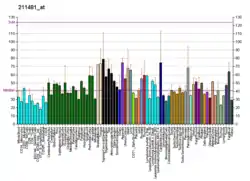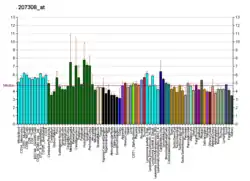| SLCO1A2 | |||||||||||||||||||||||||||||||||||||||||||||||||||
|---|---|---|---|---|---|---|---|---|---|---|---|---|---|---|---|---|---|---|---|---|---|---|---|---|---|---|---|---|---|---|---|---|---|---|---|---|---|---|---|---|---|---|---|---|---|---|---|---|---|---|---|
| Identifiers | |||||||||||||||||||||||||||||||||||||||||||||||||||
| Aliases | SLCO1A2, OATP, OATP-A, OATP1A2, SLC21A3, solute carrier organic anion transporter family member 1A2 | ||||||||||||||||||||||||||||||||||||||||||||||||||
| External IDs | OMIM: 602883 MGI: 1351865 HomoloGene: 56603 GeneCards: SLCO1A2 | ||||||||||||||||||||||||||||||||||||||||||||||||||
| |||||||||||||||||||||||||||||||||||||||||||||||||||
| |||||||||||||||||||||||||||||||||||||||||||||||||||
| |||||||||||||||||||||||||||||||||||||||||||||||||||
| |||||||||||||||||||||||||||||||||||||||||||||||||||
| |||||||||||||||||||||||||||||||||||||||||||||||||||
| Wikidata | |||||||||||||||||||||||||||||||||||||||||||||||||||
| |||||||||||||||||||||||||||||||||||||||||||||||||||
Solute carrier organic anion transporter family member 1A2 is a protein that in humans is encoded by the SLCO1A2 gene.[5][6]
This gene encodes a sodium-independent transporter which mediates cellular uptake of organic ions in the liver. Its substrates include bile acids, bromosulphophthalein, and some steroidal compounds. The protein is a member of the SLC21A family of solute carriers. Alternate splicing of this gene results in three transcript variants encoding two different isoforms.[6]
See also
References
- 1 2 3 GRCh38: Ensembl release 89: ENSG00000084453 - Ensembl, May 2017
- 1 2 3 GRCm38: Ensembl release 89: ENSMUSG00000063975 - Ensembl, May 2017
- ↑ "Human PubMed Reference:". National Center for Biotechnology Information, U.S. National Library of Medicine.
- ↑ "Mouse PubMed Reference:". National Center for Biotechnology Information, U.S. National Library of Medicine.
- ↑ Kullak-Ublick GA, Beuers U, Meier PJ, Domdey H, Paumgartner G (Apr 1997). "Assignment of the human organic anion transporting polypeptide (OATP) gene to chromosome 12p12 by fluorescence in situ hybridization". J Hepatol. 25 (6): 985–7. doi:10.1016/S0168-8278(96)80307-2. PMID 9007731.
- 1 2 "Entrez Gene: SLCO1A2 solute carrier organic anion transporter family, member 1A2".
Further reading
- Meier PJ, Eckhardt U, Schroeder A, et al. (1998). "Substrate specificity of sinusoidal bile acid and organic anion uptake systems in rat and human liver". Hepatology. 26 (6): 1667–77. doi:10.1002/hep.510260641. PMID 9398014. S2CID 20039812.
- Kullak-Ublick GA, Hagenbuch B, Stieger B, et al. (1995). "Molecular and functional characterization of an organic anion transporting polypeptide cloned from human liver". Gastroenterology. 109 (4): 1274–82. doi:10.1016/0016-5085(95)90588-X. PMID 7557095.
- Kullak-Ublick GA, Beuers U, Fahney C, et al. (1997). "Identification and functional characterization of the promoter region of the human organic anion transporting polypeptide gene". Hepatology. 26 (4): 991–7. doi:10.1002/hep.510260429. PMID 9328325. S2CID 43606355.
- Kullak-Ublick GA, Fisch T, Oswald M, et al. (1998). "Dehydroepiandrosterone sulfate (DHEAS): identification of a carrier protein in human liver and brain". FEBS Lett. 424 (3): 173–6. doi:10.1016/S0014-5793(98)00168-9. PMID 9539145. S2CID 21231745.
- König J, Cui Y, Nies AT, Keppler D (2000). "Localization and genomic organization of a new hepatocellular organic anion transporting polypeptide". J. Biol. Chem. 275 (30): 23161–8. doi:10.1074/jbc.M001448200. PMID 10779507.
- Tamai I, Nezu J, Uchino H, et al. (2000). "Molecular identification and characterization of novel members of the human organic anion transporter (OATP) family". Biochem. Biophys. Res. Commun. 273 (1): 251–60. doi:10.1006/bbrc.2000.2922. PMID 10873595.
- Speek M (2001). "Antisense Promoter of Human L1 Retrotransposon Drives Transcription of Adjacent Cellular Genes". Mol. Cell. Biol. 21 (6): 1973–85. doi:10.1128/MCB.21.6.1973-1985.2001. PMC 86790. PMID 11238933.
- Strausberg RL, Feingold EA, Grouse LH, et al. (2003). "Generation and initial analysis of more than 15,000 full-length human and mouse cDNA sequences". Proc. Natl. Acad. Sci. U.S.A. 99 (26): 16899–903. Bibcode:2002PNAS...9916899M. doi:10.1073/pnas.242603899. PMC 139241. PMID 12477932.
- Lee W, Glaeser H, Smith LH, et al. (2005). "Polymorphisms in human organic anion-transporting polypeptide 1A2 (OATP1A2): implications for altered drug disposition and central nervous system drug entry". J. Biol. Chem. 280 (10): 9610–7. doi:10.1074/jbc.M411092200. PMID 15632119.
- Su Y, Zhang X, Sinko PJ (2005). "Human organic anion-transporting polypeptide OATP-A (SLC21A3) acts in concert with P-glycoprotein and multidrug resistance protein 2 in the vectorial transport of Saquinavir in Hep G2 cells". Mol. Pharm. 1 (1): 49–56. doi:10.1021/mp0340136. PMID 15832500.
- Kimura K, Wakamatsu A, Suzuki Y, et al. (2006). "Diversification of transcriptional modulation: Large-scale identification and characterization of putative alternative promoters of human genes". Genome Res. 16 (1): 55–65. doi:10.1101/gr.4039406. PMC 1356129. PMID 16344560.
This article incorporates text from the United States National Library of Medicine, which is in the public domain.
This article is issued from Wikipedia. The text is licensed under Creative Commons - Attribution - Sharealike. Additional terms may apply for the media files.






